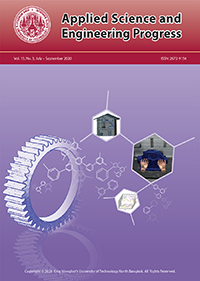The Influence of Manganese Oxide on the Densification and Mechanical Properties of 3Y-TZP Ceramics
Main Article Content
Abstract
With outstanding integration of mechanical performances and biocompatibility, 3 mol% of yttria stabilised tetragonal zirconia polycrystals (3Y-TZP) ceramic are extensively fabricated as biomedical implants. Conventional sintering (CS) was generally employed to produce 3Y-TZP bodies with promising densification, which resulted in grain coarsening and mechanical properties deterioration due to elevated sintering temperatures (> 1500°C). The main weakness of 3Y-TZP ceramic is the spontaneous tetragonal to monoclinic phase transformation under humid environment, which is known as low-temperature degradation (LTD). In present work, undoped and MnO2 (0.3 and 0.5 wt%) doped 3Y-TZP green bodies were prepared and subjected to CS at 1200–1500°C for an hour of dwelling time. It was found that the optimum concentration of MnO2 dopant was 0.5 wt%. Reasonable toughness values of 5–7 MPa.m1/2 revealed the tetragonal phase stability of 3Y-TZP grains was not altered by doping of MnO2. Moreover, outstanding density level of > 96% of 0.5 wt% MnO2 doped 3Y-TZP ceramics demonstrated the superb Young’s modulus of > 200 GPa and Vicker’s hardness of >13 GPa. Fabrication of 3Y-TZP by doping MnO2 had reduced the total processing time by ~ 9% and sintering temperature by up to 150°C when compared to undoped 3Y-TZP ceramics sintered at 1400°C.
Article Details
References
[2] C. Piconi, W. Burger, H. G. Richter, A. Cittadini, G. Maccauro, V. Covacci, N. Bruzzese, G. A. Ricci, and E. Marmo, “Y-TZP ceramics for artificial joint replacements,” Biomaterials, vol. 19, no. 16, pp. 1489–1494, Aug. 1998.
[3] J. Chevalier, D. Deville, M. Etienne, J. Romain, and L. Frédéric, “Critical effect of cubic phase on aging in 3 mol% yttria-stabilized zirconia ceramics for hip replacement prosthesis,” Biomaterials, vol. 25, no. 24, pp. 5539–5545, Nov. 2004.
[4] R. M. McMeeking and A. G. Evans, “Mechanics of transformation-toughening in brittle materials,” Journal of American Ceramic Society, vol. 65, no. 5, pp. 242–246. May. 1982.
[5] S. Gobain, Information on Breakages Reported on Prozyr Femoral Heads. France: St. Gobain Desmarquest Inc., 2004.
[6] M. Hisbergues, S. Vendeville, and P. Vendeville, “Review zirconia: Established facts and perspectives for a biomaterial in dental implantology,” Journal of Biomedical Materials Research - Part B Applied Biomaterials, vol. 88, no. 2, pp. 519–529, Feb. 2009.
[7] Y. W. Chen, J. Moussi, J. L. Drury, and J. C. Wataha, “Zirconia in biomedical applications,” Expert Review of Medical Devices, vol. 13, no. 10, pp. 945–963, Oct. 2016.
[8] R. Vaderholbi and S. Saha, “Microwave sintering of ceramics for dentistry: Part 2,” Dentistry, vol. 5, no. 7, pp. 1–4, 2015.
[9] S. Ramesh, K. Y. S. Lee, C. Y. Tan, Y. H. Wong, U. J. Alengaram, F. Tarlochan, S. Ramesh, W. D. Teng, U. Sutharsini, and A. D. A. Sarhan, “Effect of microwave sintering on the properties of copper oxide doped Y-TZP ceramics,”Ceramics International, vol. 44, no. 16, pp. 19639–19645, Nov. 2018.
[10] C. H. Ting, S. Ramesh, C. Y. Tan, Z. A. N. Ishida, W. D. Teng, I. Urries, and L. T. Bang, “Low-temperature sintering and prolonged holding time on the densification and properties of zirconia ceramic,” Journal of Ceramic Processing Research, vol. 18, no. 8, pp. 569–574, Jan. 2017.
[11] S. Ramesh, S. Meenaloshini, C. Y. Tan, W. J. K. Chew, and W. D. Teng, “Effect of manganese oxide on the sintered properties and low temperature degradation of Y-TZP ceramics,” Ceramics International, vol. 34, no. 7, pp. 1603–1608, Sep. 2008.
[12] S. Ramesh, M. Amiriyan, S. Meenaloshini, R. Tolouer, M. Hamdi, J. Pruboloksono, and W. D. Teng, “Densification behaviour and properties of manganese oxide doped Y-TZP ceramics,” Ceramics International, vol. 37, no. 8, pp. 3583– 3590, Dec. 2011.
[13] K. Niihara, R. Morena, and D. P. H. Hasselman, “Evaluation of KIc of brittle solids by the indentation method with low crack-to-indent ratios,” Journal of Materials Science Letters, vol. 1, no. 1, pp. 13–16, Jan. 1982.
[14] L. Jiang, Y. Liao, Q. Wan, and W. Li, “Effects of sintering temperature and particle size on the translucency of zirconium dioxide dental ceramic,” Journal of Materials Science: Materials in Medicine, vol. 22, no. 11, pp. 2429–2435, Nov. 2011.
[15] A. H. N. Nadia, S. Ramesh, C. Y. Tan, H. W. Yew, Z. A. N. Ishida, W. D. Teng, U. Sutharsinim, and A. D. S. Ahmed, “The effects of sintering additives on the mechanical properties and microstructure evolution of 3 mol% Y-TZP,” Journal of Ceramic Processing Research, vol. 18, no. 7, pp. 483–487, Jan. 2017.
[16] M. Mazaheri, A. Simchi, and F. Golestani-Fard, “Densification and grain growth of nanocrystalline 3Y-TZP during two-step sintering,” Journal of European Ceramic Society, vol. 28, no. 15, pp. 2933– 2939, Nov. 2008.
[17] T. Kobuko, Bioceramics and their Clinical Applications. Cambridge, England: Woodhead Publishing Limited, 2008, p. 257.
[18] Implants for surgery - ceramic materials based on yttria-stabilized tetragonal zirconia (T-TZP), ISO 13356:2015, 2015.
[19] M. M. Khan, S. Ramesh, L. T. Bang, H. W. Yew, U. Sutharsini, C. Y. Tan, J. Purbolaksono, and M. Halina, “Effect of copper oxide and manganese oxide on properties and low temperature degradation of sintered Y-TZP ceramic,” Ceramics International, vol. 23, no. 12, pp. 4328– 4335, Dec. 2014.
[20] A. Rittidech and N. Suekwamsue, “Influence of yttria additives on structural, microstructural and mechanical properties of alumina-zirconia composites prepared by two-stage sintering,” Ceramics International, vol. 41, no. 1, pp. S123– S126, Jul. 2015.
[21] Z. Pędzich and C. Wajler, “Slow crack propagation in Y-TZP/metal composites,” Journal of European Ceramic Society, vol. 26, no. 4–5, pp. 679–682, Jan. 2006.
[22] R. Dinesh, G Mohsen, S. Meenaloshini, M. D. E. Hoque, A. M. H. Ng, J. G. Mariyam, and A. K. Ariffin, “Advanced 3Y-TZP bioceramic doped with Al2O3 and MnO2 particles potentially for biomedical applications: Study on mechanical and degradation properties,” Journal of Materials Research and Technology, vol. 7, no. 4, pp. 432– 442, 2018.


